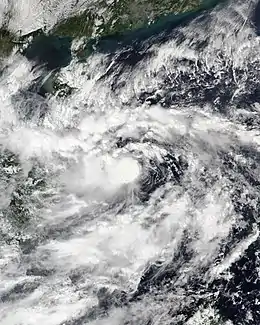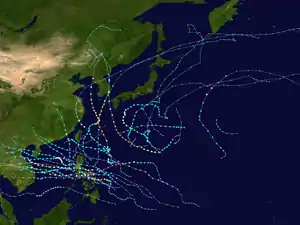Tropical Storm Linfa
Tropical Storm Linfa was a weak, short-lived but deadly and destructive tropical cyclone that was the eleventh wettest tropical cyclone on record, and was the first of six tropical cyclones in a row to strike Vietnam. Linfa caused extremely catastrophic flooding in portions of Central Vietnam in October 2020. The fifteenth tropical cyclone of the 2020 Pacific typhoon season, Linfa formed from a tropical depression west of the Philippines on October 6. After emerging to the South China Sea, the system became a tropical storm on October 10. The system tracked west and made landfall in Vietnam on the next day, in the region that has already been devastated by monsoon seasonal flood. The storm dropped historical amounts of water in many areas, worsened and triggered the floods. In total it killed 137 people and left 22 missing in Mainland Southeast Asia.
| Tropical storm (JMA scale) | |
|---|---|
| Tropical storm (SSHWS) | |
 Tropical Storm Linfa approaching Vietnam on October 11 | |
| Formed | October 6, 2020 |
| Dissipated | October 12, 2020 |
| Highest winds | 10-minute sustained: 75 km/h (45 mph) 1-minute sustained: 85 km/h (50 mph) |
| Lowest pressure | 994 hPa (mbar); 29.35 inHg |
| Fatalities | 138 total, 22 missing |
| Damage | $217 million (2020 USD)[1] |
| Areas affected | Philippines, Vietnam, Cambodia, Laos, Thailand, Myanmar |
| Part of the 2020 Pacific typhoon season | |
Meteorological history

According to post-analytic data by the Japan Meteorological Agency (JMA), Tropical Storm Linfa developed as a weak tropical depression just to the east of Bicol Region, Philippines on 18:00 UTC of October 6.[2] After crossing the Philippine archipelago of Luzon and entering the waters of the South China Sea, the Joint Typhoon Warning Center (JTWC) issued a tropical cyclone formation alert.[3] Shortly thereafter, operationally, the JMA began tracking the system around 12:00 UTC of October 9.[4] Twelve hours later, the JMA started initiating advisories on the tropical depression.[5] After animated satellite imagery depicted a defined low-level circulation center (LLCC) along with flaring deep convection,[6] the JTWC followed suit on classifying the system as a tropical depression and began issuing advisories, giving the identifier of 17W.[7] Being located in warm sea-surface temperatures and low wind shear, the system's overall structure improved.[8] Due to this, the JTWC upgraded 17W to a tropical storm on 15:00 UTC of October 10.[9] Three hours later, the JMA also upgraded the system to a tropical storm, receiving the name Linfa – the fifteenth named storm of the annual typhoon season.[2]
Linfa slowly consolidated throughout the rest of the day. Microwave imagery depicted continued wrapping of deep convection to its LLCC, which prompted the JTWC to increase Linfa's 1-minute sustained winds to 40 knots (75 km/h; 45 mph).[10] By 00:00 UTC of October 11, Linfa reached its peak intensity with 10-minute sustained winds of 45 knots (85 km/h; 50 mph) and a minimum barometric pressure of 994 hPa (29.35 inHg) according to the JMA. However, its peak intensity only lasted for 6 hours.[2] Linfa shortly later made landfall to the south of Da Nang, Vietnam. As the storm moved over land, its LLCC no longer became defined and was partially exposed; the JTWC issued their final advisory on Linfa on 06:00 UTC of October 11.[11] The JMA analysed that Linfa weakened back to a tropical depression six hours later,[2] however originally they did not issue their final advisory until 18:00 UTC of the same day.[12] The JMA tracked Linfa until it fully dissipated on 12:00 UTC of October 12.[2]
Preparations and impact

Before Linfa, from October 5 the areas of central Vietnam have already suffered very heavy rainfall and flash floods. From date 10 to October 13, it brought historic amounts of precipitation to Central Vietnam, peaking at 90.16 inches (2,290 mm) in A Lưới (Huế),[13] 59.842 inches (1,520 mm) in Quảng Trị, triggered the historical flood.[14] Linfa hit the central region of the country, destroying a total of 382 houses and flooded 109,034 others In addition, its flood damaged 165.5 km of national highways and 140.1 km of provincial highways. The disaster caused big losses to agricultural production by destroying 6,989 hectares (17,270 acres) of rice crops and vegetable crops, and 2,141 hectares (5,290 acres) of aquaculture, whilst killing about 685,225 cattle and poultry.[15] On the night of 12 to 13 October 2020, when leading the rescue team of workers at a hydropower plant (Thua Thien Hue) to find missing workers buried in a landslide, Major General Nguyễn Văn Man was buried in another landslide with 12 people from the rescue team.[16] On October 15, 2020, their bodies were found by rescuers.[17] The storm left 112 people dead and 22 missing in Vietnam.[18][19]
In Cambodia, heavy flood due to Linfa killed 25 people. The floods have also inundated 73,720 houses and 293,177 hectares of rice and other crops.[20]
Aftermath
Quang Tri authorities have asked the central government to supply materials and rescue equipment, including two amphibious vehicles, 27 boats, rescue equipment and chemicals for disinfection.[15]
Retirement
After the season, the Typhoon Committee announced that the name Linfa, along with four others will be removed from the naming lists, with replacements to be announced in 2022.[21]
See also
- Tropical cyclones in 2020
- List of wettest tropical cyclones
- Tropical Storm Noul (2020) - another storm that made landfall a few weeks prior in Vietnam and killed more than 18 people
- Tropical Storm Nangka (2020) - another deadly storm that enhanced flooding issues in Vietnam
- September 2009 Vietnam tropical depression – a weak system that affected Vietnam in September 2009.
- October 2017 Vietnam tropical depression - another weak but deadly system made landfall on central Vietnam and killed 109 people in October 2017.
References
- "62 dead, 5 missing in Vietnam's natural disasters_china.org.cn". t.m.china.org.cn. Retrieved 2020-11-30.
- "RSMC Tropical Cyclone Best Track 2015 LINFA (2015)". Japan Meteorological Agency. Retrieved January 14, 2021.
- "Tropical Cyclone Formation Alert (INVEST 92W) WTPN21 PGTW 091100". Joint Typhoon Warning Center. October 9, 2020.
- "WTPN21 PGTW 091100". Japan Meteorological Agency. October 9, 2020.
- "RSMC Tropical Cyclone Advisory TD". Japan Meteorological Agency. October 10, 2020.
- "Prognostic Reasoning for Tropical Depression 17W (Seventeen) Warning Nr 001". Joint Typhoon Warning Center. October 10, 2020.
- "Tropical Depression 17W (Seventeen) Warning Nr 001". Joint Typhoon Warning Center. October 10, 2020.
- "Prognostic Reasoning for Tropical Storm 17W (Seventeen) Warning Nr 003". Joint Typhoon Warning Center. October 10, 2020.
- "Tropical Storm 17W (Seventeen) Warning Nr 003". Joint Typhoon Warning Center. October 10, 2020.
- "Prognostic Reasoning for Tropical Storm 17W (Linfa) Warning Nr 004". Joint Typhoon Warning Center. October 10, 2020.
- "Tropical Storm 17W (Linfa) Warning Nr 006". Joint Typhoon Warning Center. October 11, 2020.
- "RSMC Tropical Cyclone Advisory TD DOWNGRADED FROM TS 2015 LINFA (2015)". Japan Meteorological Agency. October 11, 2020.
- "FLASH REPORT ON DISASTER RISK MANAGEMENT SITUATION ON 14 OCTOBER 2020". Vietnam Disaster Management Authority. 14 October 2020. Retrieved 2020-10-17.
- "3 tỉnh xin hỗ trợ khẩn cấp thiệt hại do bão số 6, áp thấp nhiệt đới". Báo Lao động. October 12, 2020. Retrieved 2020-10-14.
- "Thailand, Vietnam caught in the line of fire from increased storm activity". Phnom Penh Post. Retrieved 2020-11-30.
- "Tìm thấy thi thể Thiếu tướng Nguyễn Văn Man, Phó Tư lệnh Quân khu 4". Báo điện tử Tiền Phong. 2020-10-15. Retrieved 2020-10-15.
- Hoàng Thùy và cộng sự (2020-10-13). "Phó tư lệnh Quân khu 4 cùng 12 người gặp nạn khi đi cứu hộ". Báo điện tử VnExpress. Retrieved 2020-10-15.
- "Báo cáo nhanh công tác trực ban PCTT ngày 19/10/2020". Vietnam Disaster Management Authority (in Vietnamese). 20 October 2020. Retrieved 2020-10-20.
- "Tổng số người chết và mất tích do mưa lũ là 134: Công tác cứu trợ đang được đẩy mạnh". VOV.VN. Retrieved 2020-11-30.
- "Flood death toll in Cambodia rises to 25 as over 37,000 evacuated: spokesman". Xinhua News Agency. October 19, 2020. Retrieved 2020-10-19.
- "53rd Session of TC - Working Doc Page". typhooncommittee.org. Retrieved 2021-02-01.
External links
| Wikimedia Commons has media related to Tropical Storm Linfa (2020). |
